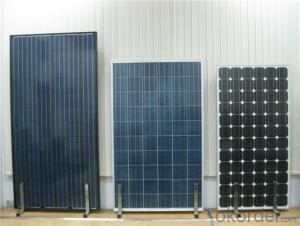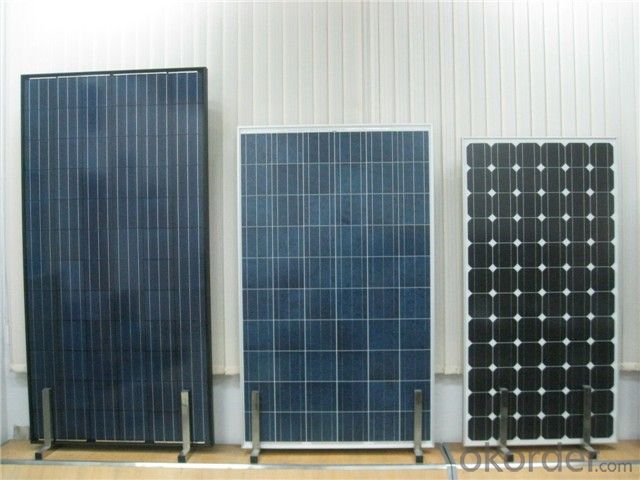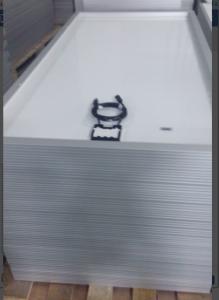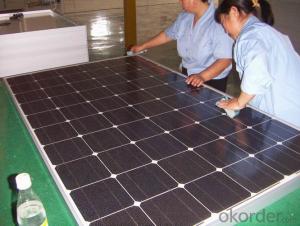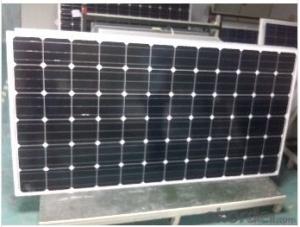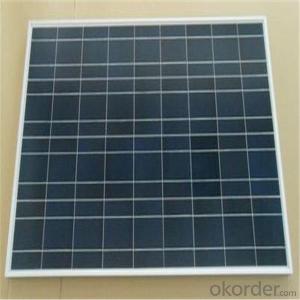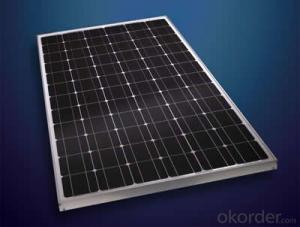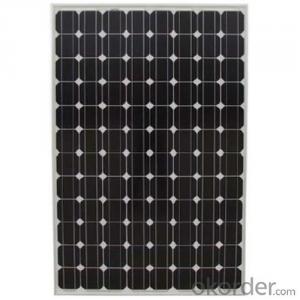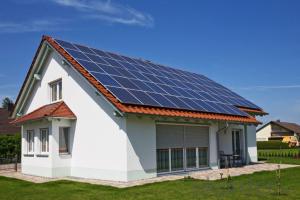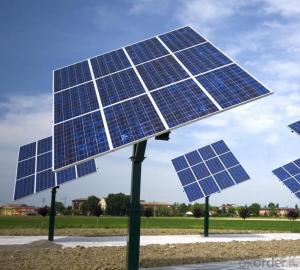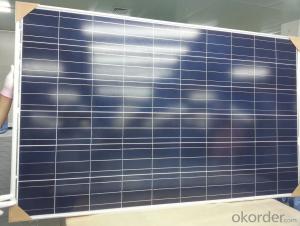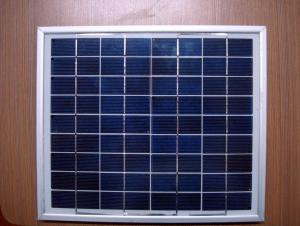Best Price on High Quality Poly Solar Module (20w - 300w) for Power Plant
- Loading Port:
- Tianjin
- Payment Terms:
- TT OR LC
- Min Order Qty:
- 100 watt
- Supply Capability:
- 10000 watt/month
OKorder Service Pledge
Quality Product, Order Online Tracking, Timely Delivery
OKorder Financial Service
Credit Rating, Credit Services, Credit Purchasing
You Might Also Like
Specification
Material:
Polycrystalline Silicon
Max. Power(W):
300
Number of Cells(pieces):
36
Size:
400*670*25mm
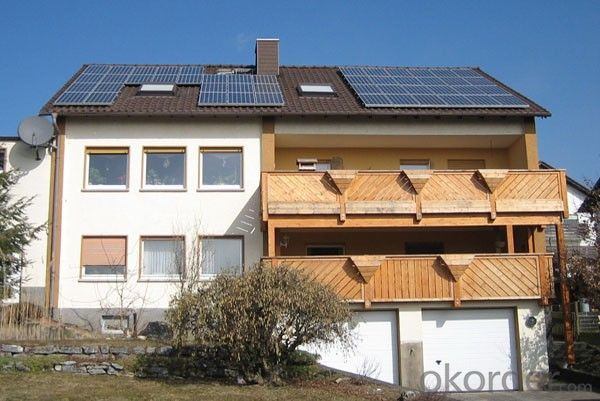
Polycrystalline cell efficiency 15 - 17% in Motech/Gintech or other brands.
Convenient location, near to Shenzhen Port & Guangzhou Port.
Price: Negotiable.
Quality Control:
100% panel power and EL test before package.
Module Warranty:
25 - year limited warranty of 80% power output;
10 - year limited warranty of 90% power output;
5 - year limited warranty of materials and workmanship.
| Electrical Characteristics | |||||||||||||||||||||||||||
| Model | GP-SP-010W-6P36 | GP-SP-020W-6P36 | GP-SP-030W-6P36 | GP-SP-035W-6P36 | GP-SP-040W-6P36 | GP-SP-045W-6P36 | |||||||||||||||||||||
| Max power (Pmax) | 10W | 20W | 30W | 35W | 40W | 45W | |||||||||||||||||||||
| Max power voltage (Vmp) | 18V± 3% | 18V± 3% | 18V± 3% | 18V± 3% | 18V± 3% | 18V± 3% | |||||||||||||||||||||
| Max power current (Imp) | 0.56A± 3% | 1.11A± 3% | 1.67A± 3% | 1.94A± 3% | 2.22A± 3% | 2.5A± 3% | |||||||||||||||||||||
| Open circuit voltage (Voc) | 21.6V± 3% | 21.6V± 3% | 21.6V± 3% | 21.6V± 3% | 21.6V± 3% | 21.6V± 3% | |||||||||||||||||||||
| Short circuit current (Isc) | 0.63A± 3% | 1.27A± 3% | 1.89A± 3% | 2.22A± 3% | 2.54A± 3% | 2.85A± 3% | |||||||||||||||||||||
| Cells | Polycrystalline | Polycrystalline | Polycrystalline | Polycrystalline | Polycrystalline | Polycrystalline | |||||||||||||||||||||
| Number of cells | 36 | 36 | 36 | 36 | 36 | 36 | |||||||||||||||||||||
| Output tolerance | ± 5% | ± 5% | ± 5% | ± 5% | ± 5% | ± 5% | |||||||||||||||||||||
| Max system voltage | 1000V | ||||||||||||||||||||||||||
| Test conditions: | AM1.5, 25º C, 1000W/M 2, | ||||||||||||||||||||||||||
| Temperature Coefficient: | Isc | 0.08%/º C | |||||||||||||||||||||||||
| Voc | - 0.32%/º C | ||||||||||||||||||||||||||
| Pmax | -0.38%/º C | ||||||||||||||||||||||||||
| Dimension (mm) | Length | 310 | 359 | 400 | 440 | 490 | 540 | ||||||||||||||||||||
| Width | 359 | 500 | 670 | 675 | 675 | 675 | |||||||||||||||||||||
| Height | 18 | 25 | 25 | 30 | 30 | 30 | |||||||||||||||||||||
| Weight(kg): | 1.2 | 2.5 | 3.6 | 4.2 | 4.8 | 5.4 | |||||||||||||||||||||
| Electrical Characteristics | |||||||||||||||||||||||||||
| Model | GP-SP-050W-6P36 | GP-SP-055W-6P36 | GP-SP-060W-6P36 | GP-SP-065W-6P36 | GP-SP-070W-6P36 | GP-SP-075W-6P36 | |||||||||||||||||||||
| Max power (Pmax) | 50W | 55W | 60W | 65W | 70W | 75W | |||||||||||||||||||||
| Max power voltage (Vmp) | 18V± 3% | 18V± 3% | 18V± 3% | 18V± 3% | 18V± 3% | 18V± 3% | |||||||||||||||||||||
| Max power current (Imp) | 2.78A± 3% | 3.06A± 3% | 3.33A± 3% | 3.61A± 3% | 3.89A± 3% | 4.17A± 3% | |||||||||||||||||||||
| Open circuit voltage (Voc) | 21.6V± 3% | 21.6V± 3% | 21.6V± 3% | 21.6V± 3% | 21.6V± 3% | 21.6V± 3% | |||||||||||||||||||||
| Short circuit current (Isc) | 3.17A± 3% | 3.49A± 3% | 3.81A± 3% | 4.12A± 3% | 4.44A± 3% | 4.76A± 3% | |||||||||||||||||||||
| Cells | Polycrystalline | Polycrystalline | Polycrystalline | Polycrystalline | Polycrystalline | Polycrystalline | |||||||||||||||||||||
| Number of cells | 36 | 36 | 36 | 36 | 36 | 36 | |||||||||||||||||||||
| Output tolerance | ± 5% | ± 5% | ± 5% | ± 5% | ± 5% | ± 5% | |||||||||||||||||||||
| Max system voltage | 1000V | ||||||||||||||||||||||||||
| Test conditions: | AM1.5, 25º C, 1000W/M 2, | ||||||||||||||||||||||||||
| Temperature Coefficient: | Isc | 0.08%/º C | |||||||||||||||||||||||||
| Voc | - 0.32%/º C | ||||||||||||||||||||||||||
| Pmax | -0.38%/º C | ||||||||||||||||||||||||||
| Dimension (mm) | Length | 600 | 645 | 700 | 750 | 800 | 850 | ||||||||||||||||||||
| Width | 675 | 675 | 675 | 675 | 675 | 675 | |||||||||||||||||||||
| Height | 30 | 35 | 35 | 35 | 35 | 35 | |||||||||||||||||||||
| Weight(kg): | 6.0 | 6.6 | 7.2 | 7.8 | 8.4 | 9.0 | |||||||||||||||||||||
| Model | GP-SP-080W-6P36 | GP-SP-085W-6P36 | GP-SP-090W-6P36 | GP-SP-095W-6P36 | GP-SP-100W-6P36 | GP-SP-110W-6P36 | |||||||||||||||||||||
| Max power(Pmax) | 80W | 85W | 90W | 95W | 100W | 110W | |||||||||||||||||||||
| Max power voltage (Vmp) | 18V± 3% | 18V± 3% | 18V± 3% | 18V± 3% | 18V± 3% | 18V± 3% | |||||||||||||||||||||
| Max power current (Imp) | 4.44A± 3% | 4.72A± 3% | 5.0A± 3% | 5.28A± 3% | 5.56A± 3% | 6.11A± 3% | |||||||||||||||||||||
| Open circuit voltage (Voc) | 21.6V± 3% | 21.6V± 3% | 21.6V± 3% | 21.6V± 3% | 21.6V± 3% | 21.6V± 3% | |||||||||||||||||||||
| Short circuit current (Isc) | 5.07A± 3% | 5.25A± 3% | 5.71A± 3% | 6.02A± 3% | 6.34A± 3% | 6.98A± 3% | |||||||||||||||||||||
| Cells | Polycrystalline | Polycrystalline | Polycrystalline | Polycrystalline | Polycrystalline | Polycrystalline | |||||||||||||||||||||
| Number of cells | 36 | 36 | 36 | 36 | 36 | 36 | |||||||||||||||||||||
| Output tolerance | ± 5% | ± 5% | ± 5% | ± 5% | ± 5% | ± 5% | |||||||||||||||||||||
| Max system voltage | 1000V | ||||||||||||||||||||||||||
| Test conditions | AM1.5, 25º C, 1000W/M 2, | ||||||||||||||||||||||||||
| Temperature Coefficient: | Isc | 0.08%/º C | |||||||||||||||||||||||||
| Voc | - 0.32%/º C | ||||||||||||||||||||||||||
| Pmax | -0.38%/º C | ||||||||||||||||||||||||||
| Dimension (mm) | Length | 904 | 955 | 1010 | 1060 | 1130 | 1210 | ||||||||||||||||||||
| Width | 675 | 675 | 675 | 675 | 675 | 675 | |||||||||||||||||||||
| Height | 35 | 35 | 35 | 35 | 35 | 35 | |||||||||||||||||||||
| Weight(kg): | 8.8 | 9.4 | 10 | 10.5 | 11.5 | 12 | |||||||||||||||||||||
| Electrical Characteristics | |||||||||||||||||||||||||||
| Model | GP-SP-115W-6P36 | GP-SP-120W-6P36 | GP-SP-125W-6P36 | GP-SP-130W-6P36 | GP-SP-135W-6P36 | ||||||||||||||||||||||
| Max power(Pmax) | 115W | 120W | 125W | 130W | 135W | ||||||||||||||||||||||
| Max power voltage (Vmp) | 18V± 3% | 18V± 3% | 18V± 3% | 18V± 3% | 18V± 3% | ||||||||||||||||||||||
| Max power current (Imp) | 6.39A± 3% | 6.67A± 3% | 6.94A± 3% | 7.22A± 3% | 7.5A± 3% | ||||||||||||||||||||||
| Open circuit voltage (Voc) | 21.6V± 3% | 21.6V± 3% | 21.6V± 3% | 21.6V± 3% | 21.6V± 3% | ||||||||||||||||||||||
| Short circuit current (Isc) | 7.19A± 3% | 7.61A± 3% | 7.93A± 3% | 8.24A± 3% | 8.45A± 3% | ||||||||||||||||||||||
| Cells | Polycrystalline | Polycrystalline | Polycrystalline | Polycrystalline | Polycrystalline | ||||||||||||||||||||||
| Number of cells | 36 | 36 | 36 | 36 | 36 | ||||||||||||||||||||||
| Output tolerance | ± 5% | ± 5% | ± 5% | ± 5% | ± 5% | ||||||||||||||||||||||
| Max system voltage | 1000V | ||||||||||||||||||||||||||
| Test conditions | AM1.5, 25º C, 1000W/M 2, | ||||||||||||||||||||||||||
| Temperature Coefficient: | Isc | 0.08%/º C | |||||||||||||||||||||||||
| Voc | - 0.32%/º C | ||||||||||||||||||||||||||
| Pmax | -0.38%/º C | ||||||||||||||||||||||||||
| Dimension (mm) | Length | 1278 | 1320 | 1370 | 1425 | 1490 | |||||||||||||||||||||
| Width | 675 | 675 | 675 | 675 | 675 | ||||||||||||||||||||||
| Height | 35 | 35 | 35 | 35 | 35 | ||||||||||||||||||||||
| Weight(kg): | 12.8 | 14.2 | 14.8 | 15.1 | 15.5 | ||||||||||||||||||||||
- Q: Hi. I need to build a solar panel for a project. it should be able to light a 60 watt light bulb. also, it should be about 3x3 ft if it is 50% efficient. if anyone knows any websites or can help me, please answer! thanks.
- I don't have any practical experience building solar panel arrays to power a given device, but allow me to make this observation. Solar cells, when exposed to sunlight, will each generate a given amount of power (watts), and by wiring these in series, you will increase the wattage. Now, a panel three feet square will give you a certain amount of power, provided all the cells are wired correctly in series, and it may not provide enough juice to light the bulb. You can work around this by adding a step-up transformer (which takes the incoming power and boosts it to the desired level for output, with no moving parts). Voila! You've illuminated your bulb. I will admit, though, you'll have to do some math to determine what you need. A search on the Web will help you find the formulae and other information you'll require. Good luck.
- Q: What is the difference b/w them which one is better .
- Guide okorder /
- Q: Can solar panels be integrated into building materials?
- Yes, solar panels can be integrated into building materials. This integration is known as Building Integrated Photovoltaics (BIPV), where solar panels are designed to blend seamlessly into the architecture of a building, such as being incorporated into windows, roofs, or facades. BIPV offers a dual purpose of generating renewable energy while serving as a functional building material.
- Q: Can solar panels be installed on factories or industrial buildings?
- Yes, solar panels can be installed on factories or industrial buildings. In fact, it is quite common for large-scale solar installations to be implemented on such structures, as they often have expansive rooftops or open spaces suitable for maximizing solar energy generation. Installing solar panels on factories or industrial buildings can help offset power consumption, reduce carbon emissions, and provide a sustainable source of energy for these facilities.
- Q: How do solar panels impact the electric bill?
- Solar panels can significantly reduce or even eliminate the electric bill for homeowners. By generating clean and sustainable energy from sunlight, solar panels can offset the amount of electricity needed from the grid. Excess energy produced by solar panels can be fed back into the grid, earning credits or monetary compensation through net metering. Ultimately, solar panels can lead to substantial savings on the electric bill over time.
- Q: My husband is interested in buying solar panels for the roof and i dont know where to find them.
- Buying solar panels can be very expensive, especially for installation. If your average daily usage is 6.6 kilowatt per hour, then you would need a 2 kilowatt system that could generate ten kilowatts per hour in a day. This system could cost between $0,000 to $20,000. Of course, the higher wattage, the higher the cost. There are some alternatives to spending thousands of dollars on solar panels. ) Buy several solar panel kits and link them together yourself. 2) Combine solar with wind power to decrease the number of panels you will need. 3) Build your own solar panels for around $200 each. If you are handy with some basic soldering, then you can make your own solar panels.
- Q: Can solar panels be used in areas with high levels of electromagnetic radiation?
- Yes, solar panels can be used in areas with high levels of electromagnetic radiation. While electromagnetic radiation can potentially interfere with the functioning of electronic devices, solar panels are designed to withstand various environmental conditions. They are typically equipped with protective measures, such as grounding and shielding, to minimize the impact of electromagnetic radiation. Therefore, as long as the solar panels are installed correctly and maintained properly, they can continue to generate electricity efficiently even in areas with high levels of electromagnetic radiation.
- Q: i am trying to get it to work on solar power They are outdoors and we dont feel like running a few hundred feet of power cables. Thanks and best answer will get 0 points.
- Only okorder /... Each battery will will need to be enclosed in a box from the weather to preserve it as well as the charge controllers. All this work can be done with success, but will be costly if that's what you want, and want it done right. You have no short cuts around this unless you want to damage your cameras? I still say it would be much easier to run conduit under ground for your power supply to each camera, and it would cost less money and time.
- Q: Looking to install solar panels in my house.
- Wholesale prices for BP solar panels range between $335 for the 40 watts panel to $835 for the 70 watts panel. Here's a brief listing of wholesale prices for BP solar models: - BP340J solar panel (40 watts) @ $335 - BP350J solar panel (50 watts) @ $37 - BP375J solar panel (80 watts) @ $504 Right now I'm getting a series of 50 watt (7.5 volts) panels installed in my house. It's a start to reduce dependence on electricity bills and try get some tax rebates as well.
- Q: a fiber optic network could distribute solar energy from warm states to the rest of the country. Using a Federally created program,the energy would be used through a trust program to benefit all of our citizens equally. It would create thousands of jobs and help us with our dependence on foriegn oil supplies. This is no different than work programs created by the Feds during the 930's depression era.
- Claire's argument doesn't make much sense to me either. First; Claire is talking about the second law ('you can only lose or break even'), not the third law ('you can't get to absolute zero'). Easily confused, but not that important! Putting a solar panel down _can_ increase the heat absorbed by Earth. Everything has an 'albedo' (the proportion of incoming light it reflects), and Earth's average albedo is about 0.3 (ie 30% of incoming light is reflected, most of which leaves the atmosphere straight away). By putting a 0.05 albedo solar panel down on a 0.3 albedo surface, you increase the amount of sunlight that is absorbed by Earth and therefore contribute to warming. This heat is re-radiated at the Earth's temperature, in the right wavelength range to be absorbed by greenhouse gases too. If you put a panel down on equatorial ocean, or a black roof, however, there is pretty much no effect (since the albedo change is small). Also, the heating effect only lasts as long as the panel is there. Most panels are estimated to last 50 years, meanwhile CO2 has a mean lifetime of 00+ years. I did some maths and found that the 00 year averaged change in radiative forcing for solar panels was negative compared to the UK electric grid, because the reduction in CO2 emissions has a larger effect than the change in albedo. If I have spare time tomorrow I'll redo the calculations and share them. The albedo change has to be considered though!
Send your message to us
Best Price on High Quality Poly Solar Module (20w - 300w) for Power Plant
- Loading Port:
- Tianjin
- Payment Terms:
- TT OR LC
- Min Order Qty:
- 100 watt
- Supply Capability:
- 10000 watt/month
OKorder Service Pledge
Quality Product, Order Online Tracking, Timely Delivery
OKorder Financial Service
Credit Rating, Credit Services, Credit Purchasing
Similar products
Hot products
Hot Searches
Related keywords
